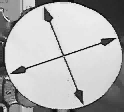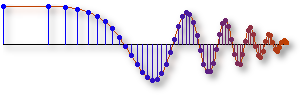
4. Sampling and Aliasing

Overview: In chapter four, the conversion of signals between the
analog and digital domains is studied. The basic ideas underlying
sampling and signal reconstruction are presented. When sampling to convert
an analog signal to a digital form for computer processing and storage,
the primary issue is aliasing and the sampling strategy necessary to
avoid aliasing. The primary objective of our presentation is an
understanding of the
Sampling Theorem which states
that the sampling rate must be greater than twice the highest frequency
contained in the analog signal. Frequency content is taken to mean
the spectral content of a signal when represented as a sum of sinusoids.
| Lab 06: Digital Images: A/D and D/A |
The objective in this lab is to introduce digital images as a
second useful signal type. We will show how the
A-to-D sampling and the D-to-A reconstruction processes are
carried out for digital images. In particular,
we will show a commonly used method of image zooming
(reconstruction) that gives “poor” results—a later
lab will revisit this issue and do a better job.
[Files]
|



